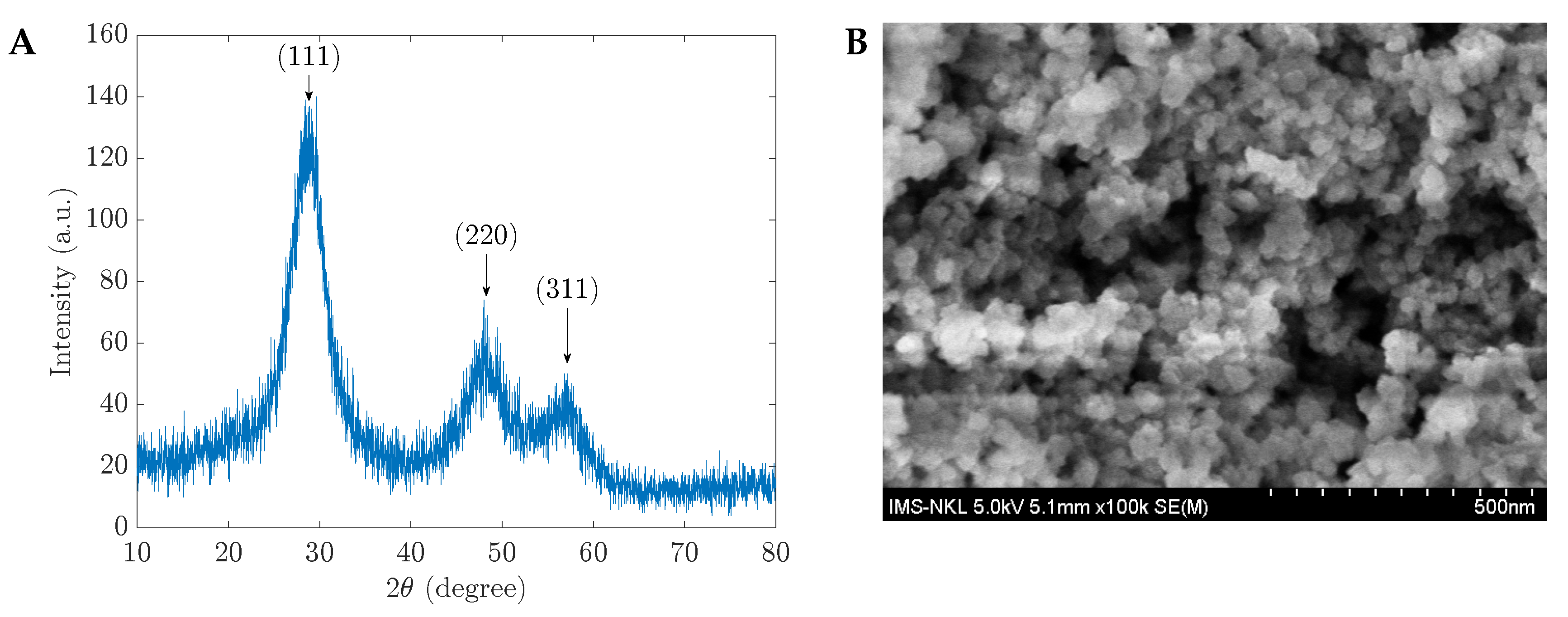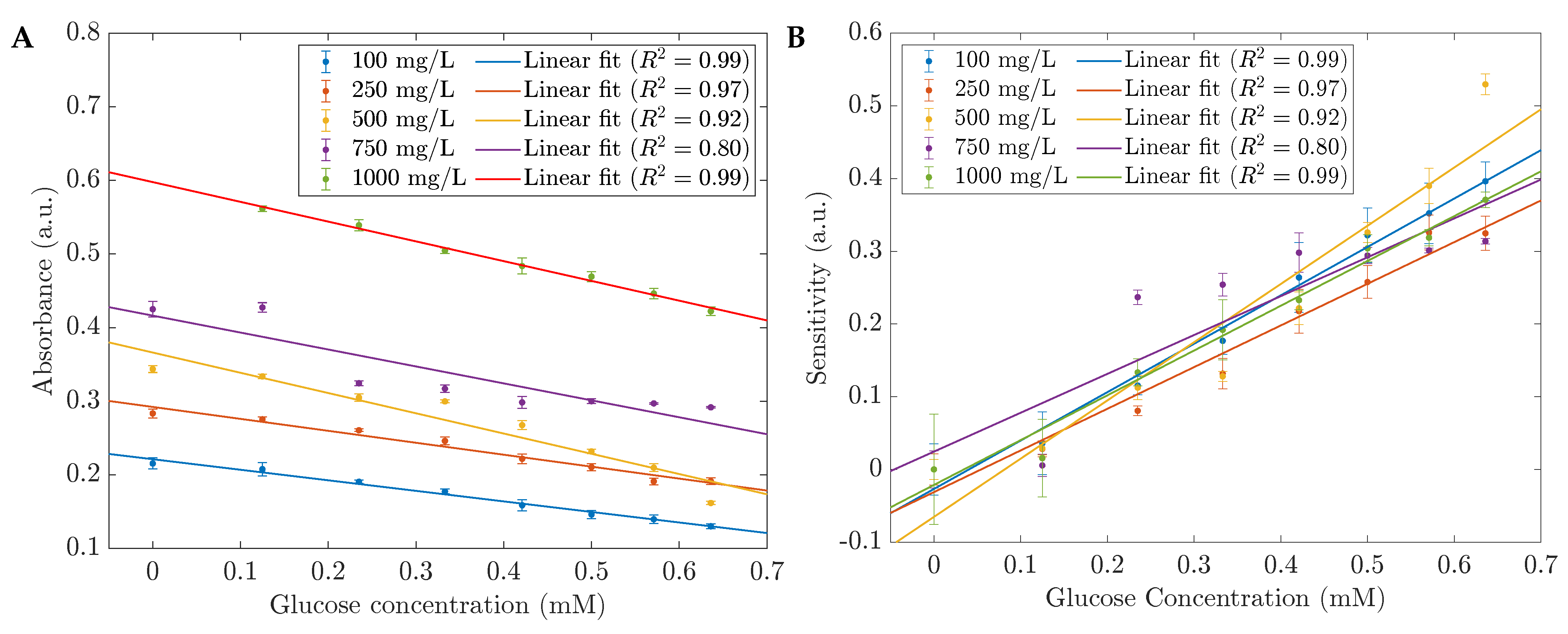Optical Glucose Sensors Based on Chitosan-Capped ZnS-Doped Mn Nanomaterials
Abstract
1. Introduction
2. Materials and Methods
2.1. Chemicals
2.2. Preparation of ZnS: Doped Mn Nanomaterials Capped with Chitosan (CH-ZnS/Mn)
2.3. Measuring the Optical Properties of Glucose Sensors Based on CH-ZnS/Mn
3. Results and Discussion
3.1. Characterizations of CH-Capped ZnS-Doped Mn Nanomaterials
3.2. UV–Vis Measurements of Glucose Sensors Based on CH-ZnS/Mn Materials
3.3. Photoluminescent Measurements of Glucose Sensors Based on CH-ZnS/Mn Materials
3.4. CH-ZnS/Mn-Based Glucose Sensor Performance for Glucose in the Artificial Saliva and Phosphate-Buffered Saline and Its Sensitivity
3.5. The Effect of %wt CH on the Biosensor’s Performance
4. Conclusions
Author Contributions
Funding
Institutional Review Board Statement
Informed Consent Statement
Data Availability Statement
Conflicts of Interest
References
- Kim, K.S.; Kim, S.K.; Sung, K.M.; Cho, Y.W.; Park, S.W. Management of type 2 diabetes mellitus in older adults. Diabetes Metab. J. 2012, 36, 336–344. [Google Scholar] [CrossRef] [PubMed]
- Yoo, E.H.; Lee, S.Y. Glucose biosensors: An overview of use in clinical practice. Sensors 2010, 10, 4558–4576. [Google Scholar] [CrossRef] [PubMed]
- Zhang, W.; Du, Y.; Wang, M.L. Noninvasive glucose monitoring using saliva nano-biosensor. Sens. Bio-Sens. Res. 2015, 4, 23–29. [Google Scholar] [CrossRef]
- Hu, T.; Ye, Y.; Chen, K.; Long, F.; Sang, W.; Zhou, Y.; Sun, D.; Ni, Z. Visual detection of glucose based on quantum dots aerogel in microfluidic chips. Anal. Methods 2018, 10, 5749–5754. [Google Scholar] [CrossRef]
- Javaid, M.; Haleem, A.; Rab, S.; Singh, R.P.; Suman, R. Sensors for daily life: A review. Sensors Int. 2021, 2, 100121. [Google Scholar] [CrossRef]
- Nayak, M.K.; Singh, J.; Singh, B.; Soni, S.; Pandey, V.S.; Tyagi, S. Introduction to semiconductor nanomaterial and its optical and electronics properties. In Metal Semiconductor Core-Shell Nanostructures for Energy and Environmental Applications; Elsevier: Amsterdam, The Netherlands, 2017; pp. 1–33. [Google Scholar]
- Wilson, C.B. Sensors in medicine. BMJ 1999, 319, 1288. [Google Scholar] [CrossRef] [PubMed]
- Jana, S.; Manna, G.; Srivastava, B.B.; Pradhan, N. Tuning the emission colors of semiconductor nanocrystals beyond their bandgap tunability: All in the dope. Small 2013, 9, 3753–3758. [Google Scholar] [CrossRef]
- Kirchner, C.; Liedl, T.; Kudera, S.; Pellegrino, T.; Muñoz Javier, A.; Gaub, H.E.; Stölzle, S.; Fertig, N.; Parak, W.J. Cytotoxicity of colloidal CdSe and CdSe/ZnS nanoparticles. Nano Lett. 2005, 5, 331–338. [Google Scholar] [CrossRef]
- Bykkam, S.; Prasad, D.; Maurya, M.R.; Sadasivuni, K.K.; Cabibihan, J.J. Comparison study of metal oxides (CeO2, CuO, SnO2, CdO, ZnO and TiO2) decked few layered graphene nanocomposites for Dye-Sensitized solar cells. Sustainability 2021, 13, 7685. [Google Scholar] [CrossRef]
- Freeman, R.; Bahshi, L.; Finder, T.; Gill, R.; Willner, I. Competitive analysis of saccharides or dopamine by boronic acid-functionalized CdSe–ZnS quantum dots. Chem. Commun. 2009, 7, 764–766. [Google Scholar] [CrossRef]
- Yu, Z.; Jiang, N.; Kazarian, S.G.; Tasoglu, S.; Yetisen, A.K. Optical sensors for continuous glucose monitoring. Prog. Biomed. Eng. 2021, 3, 022004. [Google Scholar] [CrossRef]
- Akhtar, M.S.; Malik, M.A.; Alghamdi, Y.G.; Ahmad, K.S.; Riaz, S.; Naseem, S. Chemical bath deposition of Fe-doped ZnS thin films: Investigations of their ferromagnetic and half-metallic properties. Mater. Sci. Semicond. Process. 2015, 39, 283–291. [Google Scholar] [CrossRef]
- Reddy, D.A.; Kim, D.H.; Rhee, S.J.; Lee, B.W.; Liu, C. Tunable blue-green-emitting wurtzite ZnS: Mg nanosheet-assembled hierarchical spheres for near-UV white LEDs. Nanoscale Res. Lett. 2014, 9, 1–8. [Google Scholar] [CrossRef] [PubMed]
- Najim, A.; Hartiti, B.; Labrim, H.; Fadili, S.; Tahri, M.; Ertuğrul, M.; Thevenin, P.; Mehr, M.F. The effect of deposition time on the growth and properties of cupper doped zinc sulfide thin films deposited via spray pyrolysis. Mater. Chem. Phys. 2022, 290, 126481. [Google Scholar] [CrossRef]
- Pejjai, B.; Reddy, V.R.M.; Seku, K.; Kotte, T.R.R.; Park, C. Chemical bath deposition of Mn-doped ZnS thin films using greener complexing agents: Effect of Mn-doping on the optical properties. Optik 2017, 130, 608–618. [Google Scholar] [CrossRef]
- Sharma, M.; Jain, T.; Singh, S.; Pandey, O. Tunable emission in surface passivated Mn-ZnS nanophosphors and its application for Glucose sensing. AIP Adv. 2012, 2, 012183. [Google Scholar] [CrossRef]
- Nie, Q.; Tan, W.B.; Zhang, Y. Synthesis and characterization of monodisperse chitosan nanoparticles with embedded quantum dots. Nanotechnology 2005, 17, 140. [Google Scholar] [CrossRef]
- Chen, W.; Joly, A.G.; Malm, J.O.; Bovin, J.O.; Wang, S. Full-Color Emission and Temperature Dependence of the Luminescence in Poly-P-phenylene ethynylene- ZnS/Mn2+ Composite Particles. J. Phys. Chem. B 2003, 107, 6544–6551. [Google Scholar] [CrossRef]
- Bankar, S.B.; Bule, M.V.; Singhal, R.S.; Ananthanarayan, L. Glucose oxidase—An overview. Biotechnol. Adv. 2009, 27, 489–501. [Google Scholar] [CrossRef]
- Qi, G.; Wang, Y.; Zhang, B.; Sun, D.; Fu, C.; Xu, W.; Xu, S. Glucose oxidase probe as a surface-enhanced Raman scattering sensor for glucose. Anal. Bioanal. Chem. 2016, 408, 7513–7520. [Google Scholar] [CrossRef]
- Pham, X.H.; Shim, S.; Kim, T.H.; Hahm, E.; Kim, H.M.; Rho, W.Y.; Jeong, D.H.; Lee, Y.S.; Jun, B.H. Glucose detection using 4-mercaptophenyl boronic acid-incorporated silver nanoparticles-embedded silica-coated graphene oxide as a SERS substrate. BioChip J. 2017, 11, 46–56. [Google Scholar] [CrossRef]
- Elsherif, M.; Hassan, M.U.; Yetisen, A.K.; Butt, H. Hydrogel optical fibers for continuous glucose monitoring. Biosens. Bioelectron. 2019, 137, 25–32. [Google Scholar] [CrossRef] [PubMed]
- Zheng, W.; Han, B.; Siyu, E.; Sun, Y.; Li, X.; Cai, Y.; Zhang, Y.n. Highly-sensitive and reflective glucose sensor based on optical fiber surface plasmon resonance. Microchem. J. 2020, 157, 105010. [Google Scholar] [CrossRef]
- Raghuram, H.; Pradeep, S.; Dash, S.; Chowdhury, R.; Mazumder, S. Chitosan-encapsulated ZnS: M (M: Fe3+ or Mn2+) quantum dots for fluorescent labelling of sulphate-reducing bacteria. Bull. Mater. Sci. 2016, 39, 405–413. [Google Scholar] [CrossRef]
- Chen, J.; Zhu, Y.; Zhang, Y. Room-temperature phosphorescence probe based on Mn-doped ZnS quantum dots for the sensitive and selective detection of selenite. RSC Adv. 2016, 6, 62193–62199. [Google Scholar] [CrossRef]








| Biosensor Material | Detection Techniques | Linear Range (mM) | LOD (mM) | Ref. |
|---|---|---|---|---|
| Ag NP-GOx | Surface-enhanced Raman scattering (SERS) | 2.0–14.0 | 2.0 | [21] |
| GO@SiO2@Ag NPs@MPBA | Surface-enhanced Raman scattering (SERS) | 2.0–20.0 | 2.0 | [22] |
| Hydrogel fiber | Optical | 0.0–20.0 | NA | [23] |
| Au film-GOx | Optical fiber surface plasmon resonance (SPR) | 0.0–2.8 | NA | [24] |
| CH-ZnS/Mn-GOx | Absorbance/fluorescence quenching | 0.125–0.636 | 0.125 | Our work |
Disclaimer/Publisher’s Note: The statements, opinions and data contained in all publications are solely those of the individual author(s) and contributor(s) and not of MDPI and/or the editor(s). MDPI and/or the editor(s) disclaim responsibility for any injury to people or property resulting from any ideas, methods, instructions or products referred to in the content. |
© 2023 by the authors. Licensee MDPI, Basel, Switzerland. This article is an open access article distributed under the terms and conditions of the Creative Commons Attribution (CC BY) license (https://creativecommons.org/licenses/by/4.0/).
Share and Cite
Nguyen, S.H.; Vu, P.K.T.; Nguyen, H.M.; Tran, M.T. Optical Glucose Sensors Based on Chitosan-Capped ZnS-Doped Mn Nanomaterials. Sensors 2023, 23, 2841. https://doi.org/10.3390/s23052841
Nguyen SH, Vu PKT, Nguyen HM, Tran MT. Optical Glucose Sensors Based on Chitosan-Capped ZnS-Doped Mn Nanomaterials. Sensors. 2023; 23(5):2841. https://doi.org/10.3390/s23052841
Chicago/Turabian StyleNguyen, Son Hai, Phan Kim Thi Vu, Hung Manh Nguyen, and Mai Thi Tran. 2023. "Optical Glucose Sensors Based on Chitosan-Capped ZnS-Doped Mn Nanomaterials" Sensors 23, no. 5: 2841. https://doi.org/10.3390/s23052841
APA StyleNguyen, S. H., Vu, P. K. T., Nguyen, H. M., & Tran, M. T. (2023). Optical Glucose Sensors Based on Chitosan-Capped ZnS-Doped Mn Nanomaterials. Sensors, 23(5), 2841. https://doi.org/10.3390/s23052841







